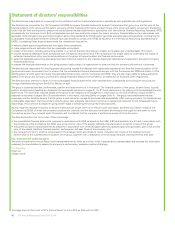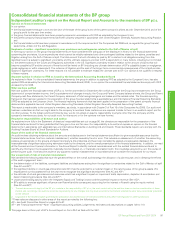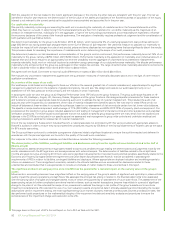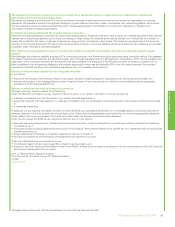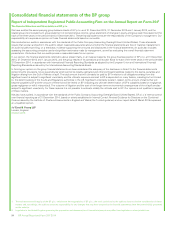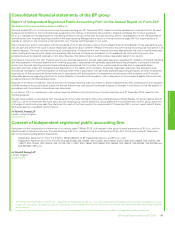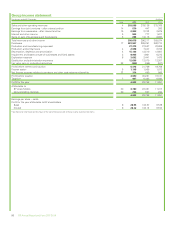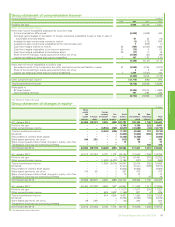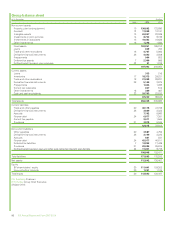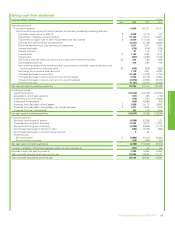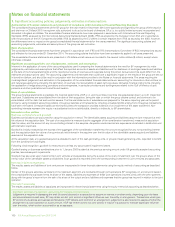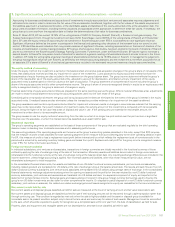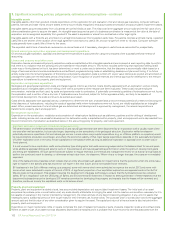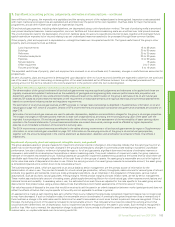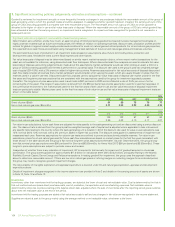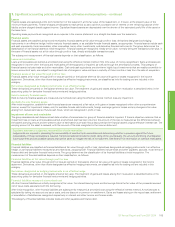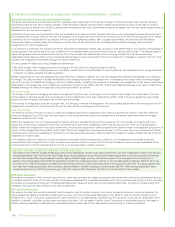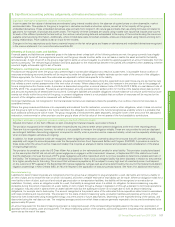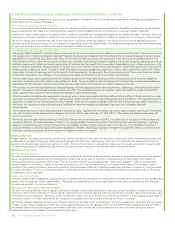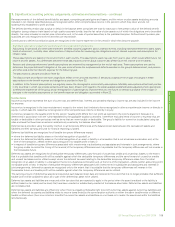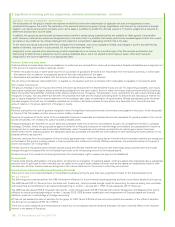BP 2014 Annual Report Download - page 104
Download and view the complete annual report
Please find page 104 of the 2014 BP annual report below. You can navigate through the pages in the report by either clicking on the pages listed below, or by using the keyword search tool below to find specific information within the annual report.
Notes on financial statements
1. Significant accounting policies, judgements, estimates and assumptions
Authorization of financial statements and statement of compliance with International Financial Reporting Standards
The consolidated financial statements of the BP group for the year ended 31 December 2014 were approved and signed by the group chief executive
and chairman on 3 March 2015 having been duly authorized to do so by the board of directors. BP p.l.c. is a public limited company incorporated and
domiciled in England and Wales. The consolidated financial statements have been prepared in accordance with International Financial Reporting
Standards (IFRS) as issued by the International Accounting Standards Board (IASB), IFRS as adopted by the European Union (EU) and in accordance
with the provisions of the UK Companies Act 2006. IFRS as adopted by the EU differs in certain respects from IFRS as issued by the IASB, however,
the differences have no impact on the group’s consolidated financial statements for the years presented. The significant accounting policies and
accounting judgements, estimates and assumptions of the group are set out below.
Basis of preparation
The consolidated financial statements have been prepared in accordance with IFRS and IFRS Interpretations Committee (IFRIC) interpretations issued
and effective for the year ended 31 December 2014. The accounting policies that follow have been consistently applied to all years presented.
The consolidated financial statements are presented in US dollars and all values are rounded to the nearest million dollars ($ million), except where
otherwise indicated.
Significant accounting policies: use of judgements, estimates and assumptions
Inherent in the application of many of the accounting policies used in preparing the financial statements is the need for BP management to make
judgements, estimates and assumptions that affect the reported amounts of assets and liabilities and the disclosure of contingent assets and liabilities
at the date of the financial statements and the reported amounts of revenues and expenses during the period. Actual outcomes could differ from the
estimates and assumptions used. The accounting judgements and estimates that could have a significant impact on the results of the group are set out
in boxed text below, and should be read in conjunction with the information provided in the Notes on financial statements. The areas requiring the
most significant judgement and estimation in the preparation of the consolidated financial statements are: accounting for interests in other entities; oil
and natural gas accounting, including the estimation of reserves; the recoverability of asset carrying values; derivative financial instruments, including
the application of hedge accounting; provisions and contingencies, in particular provisions and contingencies related to the Gulf of Mexico oil spill;
pensions and other post-retirement benefits and taxation.
Basis of consolidation
The group financial statements consolidate the financial statements of BP p.l.c. and the entities it controls (its subsidiaries) drawn up to 31 December
each year. Subsidiaries are consolidated from the date of their acquisition, being the date on which the group obtains control, and continue to be
consolidated until the date that such control ceases. The financial statements of subsidiaries are prepared for the same reporting year as the parent
company, using consistent accounting policies. Intra-group balances and transactions, including unrealized profits arising from intra-group transactions,
have been eliminated. Unrealized losses are eliminated unless the transaction provides evidence of an impairment of the asset transferred. Non-
controlling interests represent the equity in subsidiaries that is not attributable, directly or indirectly, to BP shareholders.
Interests in other entities
Business combinations and goodwill
Business combinations are accounted for using the acquisition method. The identifiable assets acquired and liabilities assumed are measured at their
fair values at the acquisition date. The cost of an acquisition is measured as the aggregate of the consideration transferred, measured at acquisition-
date fair value, and the amount of any non-controlling interest in the acquiree. Acquisition costs incurred are expensed and included in distributionand
administration expenses.
Goodwill is initially measured as the excess of the aggregate of the consideration transferred, the amount recognized for any non-controlling interest
and the acquisition-date fair values of any previously held interest in the acquiree over the fair value of the identifiable assets acquired and liabilities
assumed at the acquisition date.
At the acquisition date, any goodwill acquired is allocated to each of the cash-generating units, or groups of cash-generating units, expected to benefit
from the combination’s synergies.
Following initial recognition, goodwill is measured at cost less any accumulated impairment losses.
Goodwill arising on business combinations prior to 1 January 2003 is stated at the previous carrying amount under UK generally accepted accounting
practice, less subsequent impairments.
Goodwill may also arise upon investments in joint ventures and associates, being the surplus of the cost of investment over the group’s share of the
net fair value of the identifiable assets and liabilities. Such goodwill is recorded within the corresponding investment in joint ventures and associates.
Interests in joint arrangements
The results, assets and liabilities of joint ventures are incorporated in these financial statements using the equity method of accounting as described
below.
Certain of the group’s activities, particularly in the Upstream segment, are conducted through joint operations. BP recognizes, on a line-by-line basis in
the consolidated financial statements, its share of the assets, liabilities and expenses of these joint operations incurred jointly with the other partners,
along with the group’s income from the sale of its share of the output and any liabilities and expenses that the group has incurred in relation to the joint
operation.
Interests in associates
The results, assets and liabilities of associates are incorporated in these financial statements using the equity method of accounting as described below.
Significant estimate or judgement: accounting for interests in other entities
Judgement is required in assessing the level of control obtained in a transaction to acquire an interest in another entity; depending upon the facts
and circumstances in each case, BP may obtain control, joint control or significant influence over the entity or arrangement. Transactions which give
BP control of a business are business combinations. If BP obtains joint control of an arrangement, judgement is also required to assess whether the
arrangement is a joint operation or a joint venture. If BP has neither control nor joint control, it may be in a position to exercise significant influence
over the entity, which is then accounted for as an associate.
100 BP Annual Report and Form 20-F 2014


